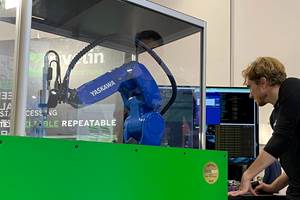Collaborators Developing Green Part Processing Solution for Cold Metal Fusion Technology
Formnext 2024: The AutoSmooth project was launched last year to develop a fully automated process chain for unpacking, depowdering and surface treatment of cold metal fusion parts.
Test specimens from the conventional CMF process chain (without green part processing) — (left to right) untreated green part, sintered part, mass-finished sintered part. Source: Rösler Oberflächentechnik GmbH
AM Solutions (a Rösler company) is developing a Green Part Processing solution for cold metal fusion (CMF) technology as part of the AutoSmooth project for additive manufacturing (AM). The project focus is to advance the pathway for mass production in metal 3D printing with the new system, which is expected to be available on the market by 2025.
Test specimens with additional AutoSmooth processing — (left to right) postprocessed green part, sintered part, mass-finished sintered part with the same processing time as above. Source: Rösler Oberflächentechnik GmbH
The group says the AutoSmooth project is showing its first promising results with regard to highly efficient processing times and significantly improved surface quality. The project was launched last year by Headmade Materials, AM Solutions and Neue Materialien Bayreuth.
Project leaders say the AutoSmooth project focuses on CMF technology and has made impressive progress. They say the system will transform the surface treatment of CMF parts, providing the “missing link” to make CMF technology — and thus metal 3D printing — suitable for mass production.
Since the project began, the partners have worked to enhance the development of a fully automated process chain for unpacking, depowdering and surface treatment of CMF parts. They say the initial results are very promising, making industrial implementation within reach.
Ensuring Surface Quality in Final Parts
AM Solutions has contributed its expertise in surface treatment to the project. The result is a system that is designed to significantly improve green part processing. A shot blasting process ensures that the surfaces of the parts are finely depowdered and smoothed in a single operation. Staircase effects are effectively removed and the surface quality is already so high that, in most applications, there is no need for an additional, lengthy finishing process after sintering — which can save significant time. For example, the process of depowdering and smoothing takes only a few minutes, whereas conventional postprocessing methods can take several hours.
Integrated 2-in-1 Solution
As part of the AutoSmooth project, AM Solutions is relying on its 2-in-1 principle — combining the two process steps of depowdering and smoothing in just one machine. Additionally, the powder is recovered so it can be reused, which ultimately results in significant cost reductions and conservation of resources. A specialized part clamping solution also ensures the careful handling of sensitive green parts during the process.
CMF Technology Advantages
CMF technology already enables users to produce high-quality metal parts in series through cost-effective AM. The main advantage is that a standard and therefore inexpensive powder bed-based polymer printer is sufficient for printing, making the process a drop-in technology for many companies. The parts do not require support structures, which would need to be removed after printing. Compared to other binder-based processes, CMF technology offers greater process reliability as the green parts are significantly more stable.
“If we now provide the ‘missing link’ in postprocessing with our new development, CMF technology will take a huge leap forward,” says Dr. Till Merkel, division manager technology at Rösler Oberflächentechnik. “For the industry, this paves the way for cost-efficient, automated processes that will fully unlock the potential of additive mass production for metal parts and significantly reduce unit costs.”
At the Formnext trade show in November, AM Solutions will offer industry professionals insights into the progress of the AutoSmooth project. The company can be found in Hall 11.1, Booth E41. The partners Headmade Materials will be located in Hall 11.1, Booth C51, and Neue Materialien Bayreuth in Hall 12.1, Booth C71.
Related Content
Chuck Jaws Achieve 77% Weight Reduction Through 3D Printing
Alpha Precision Group (APG) has developed an innovative workholding design for faster spindle speeds through sinter-based additive manufacturing.
Read MoreHow AM Enables Cobot Automation for Thyssenkrupp Bilstein (Includes Video)
The shock absorber maker has responded to its staffing shortages through extensive use of collaborative robots. In-house 3D printing makes this possible by providing the related hardware needed to complete the cobot-automated cells.
Read MoreSavage Automation Delivers 3D Printed Commercial Manufacturing Aids
The company's approach to designing end-of-arm tooling and other devices has evolved over the years to support longevity and repairs.
Read MoreThe Robot Craftsman: Force Sensing and Vision Help Realize Automated AM Postprocessing (Includes Video)
Automated production via additive manufacturing will need automated postprocessing. This UK startup is equipping robots with the capabilities needed for critical, fine-detail finishing of metal 3D printed parts.
Read MoreRead Next
Profilometry-Based Indentation Plastometry (PIP) as an Alternative to Standard Tensile Testing
UK-based Plastometrex offers a benchtop testing device utilizing PIP to quickly and easily analyze the yield strength, tensile strength and uniform elongation of samples and even printed parts. The solution is particularly useful for additive manufacturing.
Read MoreAlquist 3D Looks Toward a Carbon-Sequestering Future with 3D Printed Infrastructure
The Colorado startup aims to reduce the carbon footprint of new buildings, homes and city infrastructure with robotic 3D printing and a specialized geopolymer material.
Read More3D Printed Polymer EOAT Increases Safety of Cobots
Contract manufacturer Anubis 3D applies polymer 3D printing processes to manufacture cobot tooling that is lightweight, smooth and safer for human interaction.
Read More






















